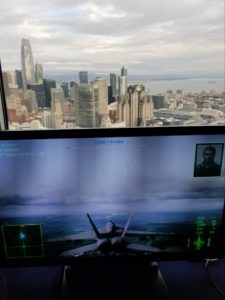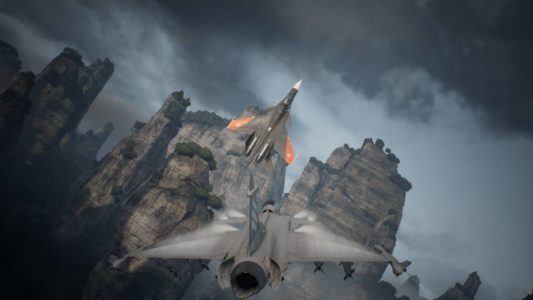When I think of air combat games, I still hear the Afterburner game soundtrack in my head. Now, Sega’s Afterburner is an old-school arcade game from the heyday of arcade gaming in the late 80s, and combat aircraft gaming has come a long way since then. Will Ace Combat 7 make as deep an impression for current-gen gamers as a 16-bit arcade game did for me years ago? We’ll give our impressions following a demo day event for the seventh iteration of Bandai Namco’s franchise air fighter.
The Event
San Francisco, frequently visited by the Blue Angels flight team and home to soaring hotel suites with a view, was the location for the Ace Combat 7 demo. While the Blue Angels weren’t part of this day, a 45-foot floor Hilton hotel suite overlooking a scenic skyline was the venue. The room with a view struck me as a good choice for a location given the type of game being demoed.

In the demo area, past the check-in area, rows of PlayStation 4 systems, controllers, monitors, and headphones, all facing out toward that aforementioned view. Off in its own set-aside space was a couple PlayStation VR (PSVR) demo stations for the exclusive version of Ace Combat 7. Behind the stations, a spread of snacks and drinks was laid out to keep media folks recharged while going through the Ace Combat 7 modes and stations.
The Game
PlayStation 4: Ace Combat 7, just over a month ahead of launch, was shown off with a free-for-all deathmatch and team deathmatch multiplayer in F16C fighters, along with three missions that led up to a boss encounter.
In the multiplayer encounters, it’s simply not as easy to score kills versus unpredictable human players as it is against the computer opponents. While I did not rank high offensively with aircraft missiles and guns, which is the best way to earn points, I was able to avoid getting killed by human opponents. It’s easy enough to evade enemies, by dropping chaff, pulling a wild maneuver to avoid the missile, or even dipping into the cloud cover. when going on the offensive, especially against skilled opponents. The closer I was the better my odds of scoring a hit, whether with guns or missiles. Avoiding a missile at some distance is easy because there’s usually enough warning of a missile zeroing on an aircraft.
In a round of 4 vs. 4 team fighting, I was able to be evasive enough to keep one or two fighters chasing me down without a kill, while my teammates worked on the other opponents. Sometimes, in a team deathmatch, it works well enough to play the bait.
The match areas can be over calm and flat terrain — or at night, in a windy storm, in treacherous terrain that can take you out as easily as a missile barrage, all of which play a role in the risks the player faces from the environment and how match strategy versus other players will unfold.
The single-player mode felt almost leisurely by comparison, with extensive cutscenes leading into missions, and between the missions. Using these cut-scenes, players immerse themselves into an emerging pseudonymous Eurasian battlefront, comprised of real aircraft but fictitious personas and organizations.

That said, players are dropped into the role of ambitious rookie Trigger of Mage Squadron, an Osean fighter matched against the surging air-land-see Erusean forces. As your squadron teammates will often remind you, especially in the early stages that also serve as a tutorial, that you are not a one-person army. They do a fair job both congratulating and humbling the player.
Speaking of tutorials, if you’re not experienced with Ace Combat-style gameplay, the single player tutorial does a very good job getting you up to speed with manageable instructions and missions, to get familiar with instrumentation, weapons, changing views, and more.
Ace Combat is a feast for the eyes, as some scenes of the sky, land, and sea scenes will look like art, and nearly suspend disbelief that one is looking at just computer-rendered imagery in motion. Water streaks on the airplane canopy in the clouds, the fog is not just a haze but a varied mixture of visibility at high speed. Mountains are deeply textured and complex, assuming, as a player, you don’t collide into it if you look for more than a long second.
As beautiful as the PlayStation 4 version is, I’d expect the PC version to be even sharper and more vivid, if this NVIDIA video of the company’s application of their sampling tech in the PC version of the game is any sign of what’s coming.

The music in the demo was adequate but not very memorable, although it accompanies the game, and particularly the cutscenes, reasonably well. The sound effects, though, were more gripping and meaningful to pay notice to anyway, since I had to pay attention to the sound of missile locks, jet engines, and other notifications.
PSVR missions: Ace Combat 7’s virtual reality missions are a stripped down form of the basic structure of Ace Combat, with three missions to experience a taste of the game in virtual reality and a bonus hangar and air show mode, for different ways of seeing aircraft on the ground and in the air.
I played through a mission, which was long enough to get used to looking around the aircraft, outside the canopy. Every motion using a joystick, or even a Thrustmaster you make is reflected in your pilot’s hands.
The PSVR version offered a more basic storyline, a lower visual fidelity, but effectively maintains the sense of speed, audio even a feeling of G-forces at work. For a moment I had visions of haptic pressure effects to simulate the G-Force partnered with this VR experience. The virtual reality goggles, which in some cases might seem isolating, actually feels like the perfect fit for this game. It’s immersive as heck to ascend to the cloud deck in pursuit of an enemy fighter, physically looking around and seeing — same as the non-VR version — moisture droplets streaming over your canopy as visibility drops into a murk of blue sky and clouds, and then hearing the roar of engines as the opposing fighter turns, jets roaring in the passage, overhead. It’s the definition of short but sweet. Hopefully, more content may come down the pipeline for this iteration of Ace Combat 7.
My take after giving the game a couple hours of playtime is that Ace Combat 7 is it is a strong entry in a well-established franchise that effectively balances fast aerial action, and solid story-telling in the single-player mode and fun multiplayer modes. The PSVR content for Ace Combat 7, even while greatly simplified in content, was arguably the more immersive and intense experience, amplified by the weather effects, sound effects and sense of flight speed in virtual reality.
For another glimpse at Ace Combat 7, Bandai Namco released two new trailers:
The A-10C in Ace Combat 7 (YouTube)
MiG-31B in Ace Combat 7 (YouTube)
Ace Combat 7 will take flight on PS4, PSVR, and Xbox One on January 18th and PC via Steam on February 1st, 2019.



